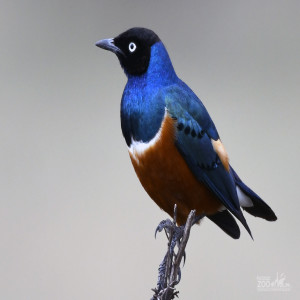 The superb starling is about seven inches long with a short tail,long narrow bill, robust body, strong feet and a distinctive plumage pattern. Adults have black heads and iridescent blue-green back, upper breast, wins, and tail. The belly is red-orange, separated from the blue breast by a white bar (only adults have the white breast band). Per the IUCN they are of LC (least conern).
The superb starling is about seven inches long with a short tail,long narrow bill, robust body, strong feet and a distinctive plumage pattern. Adults have black heads and iridescent blue-green back, upper breast, wins, and tail. The belly is red-orange, separated from the blue breast by a white bar (only adults have the white breast band). Per the IUCN they are of LC (least conern).
Location: African Elephant Crossing - Seasonal
Share:
Range
The species has a large range and can be found in East Africa, including Ethiopia, Somalia, Uganda, Kenya, Sudan, and Tanzania.
Habitat
The superb starling lives in savanna, in thorn bush and acacia arid areas, open woodland, lakeshore woodlands, gardens and cultivated fields. They can live in elevations of up to 8700 feet above sea level.
Conservation Status
Least Concerned
Primary Threats
Gestation
12 days
Litter
3-4 eggs
Behavior
The superb starling is gregarious and is generally rather tame. The superb starling has a long, loud song which consists of trills and chatters. At midday it gives a softer song of repeated phrases. They also have several harsh calls which can be shrill and screeching.
Reproduction
The breeding season lasts from October to February in Ethiopia and from March to June in Somalia. Spherical nests of grasses and twigs are built in bushes, in trees of medium height and also in rock crevices. Both the male and female take care of the offspring.
Wild Diet
The birds mainly feed on insects (grasshoppers, beetles, termites, ants and flies) and worms, but also on grains, fruits and small berries. This is mainly on the ground or in the vicinity of acacia trees.
Zoo Diet

